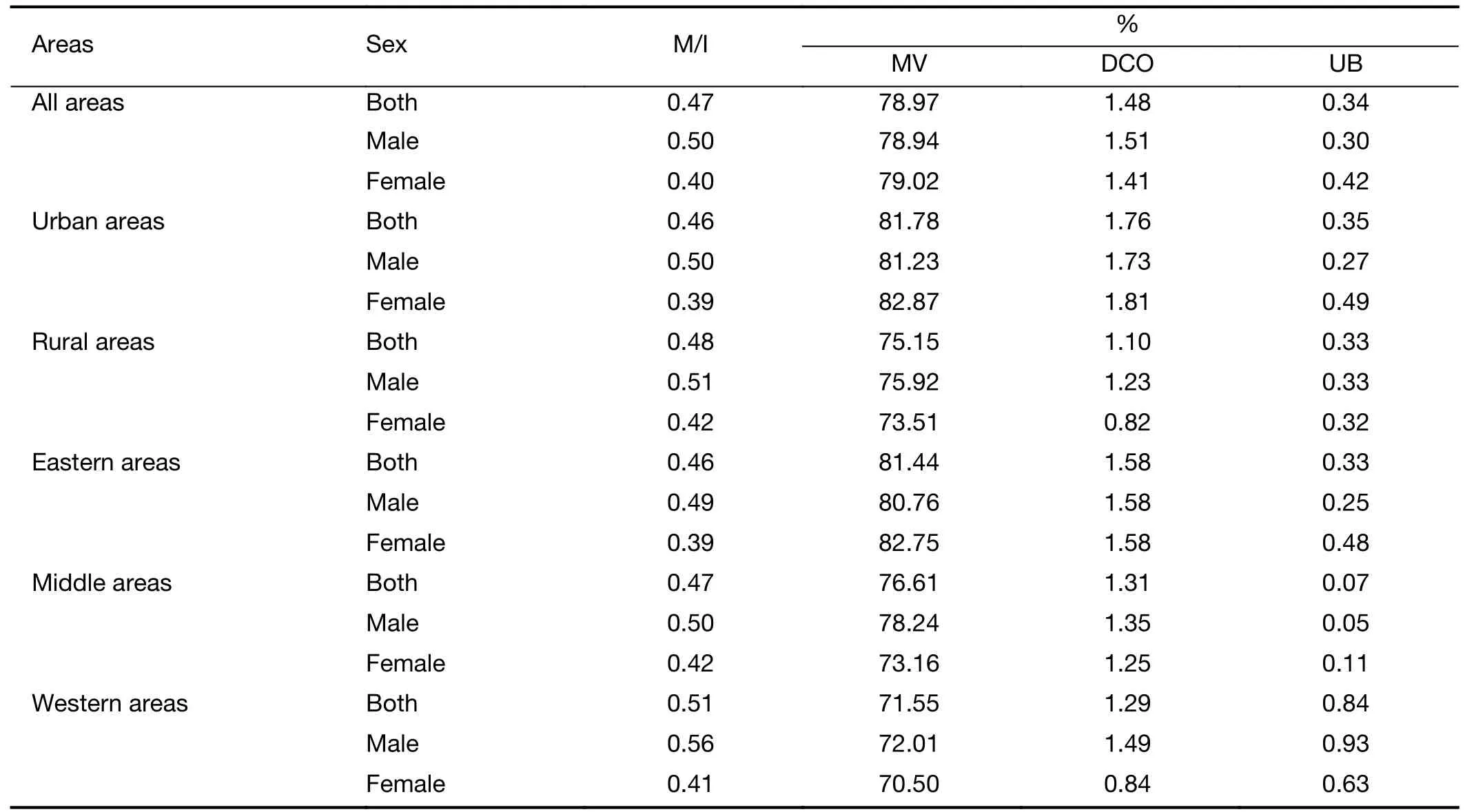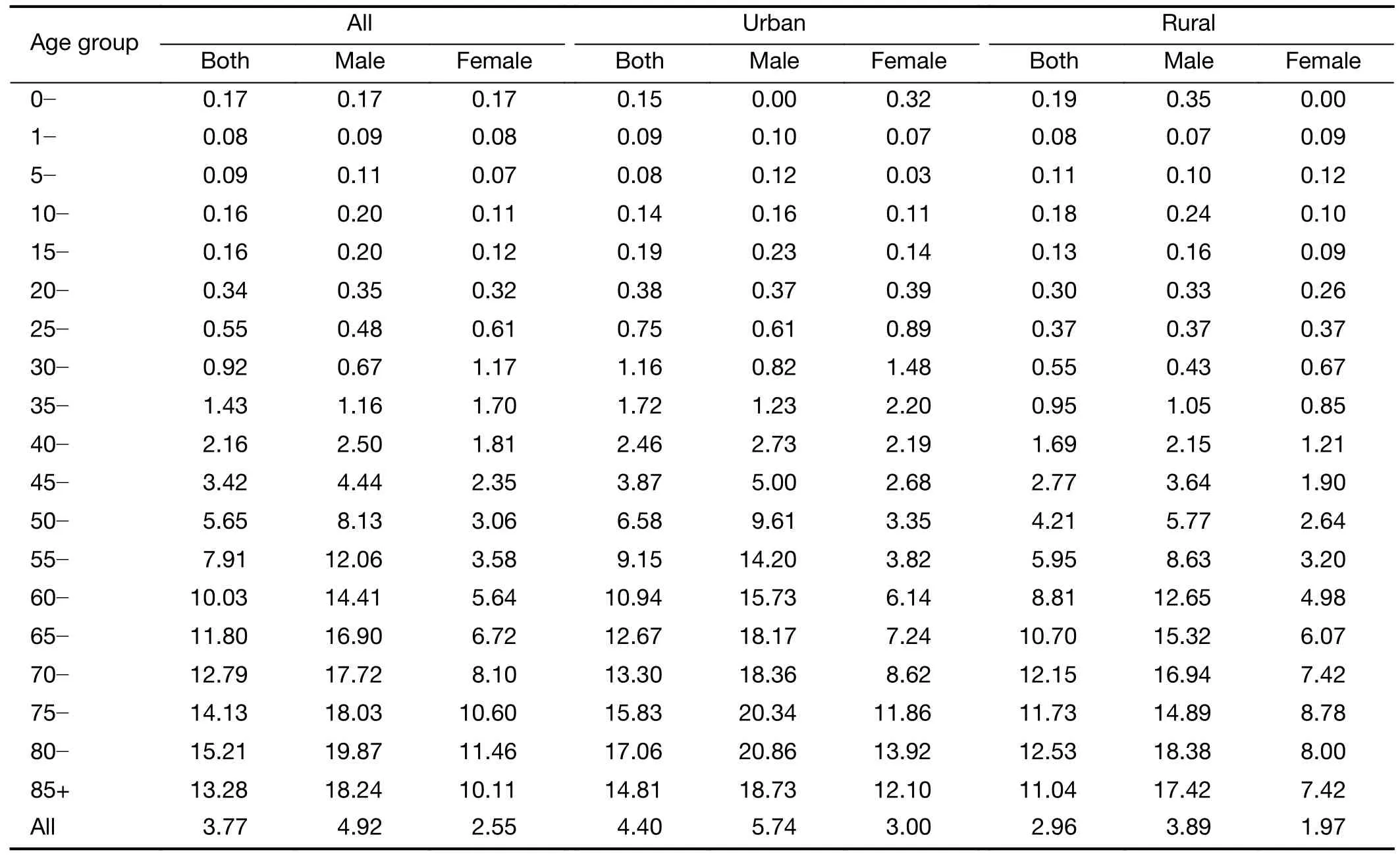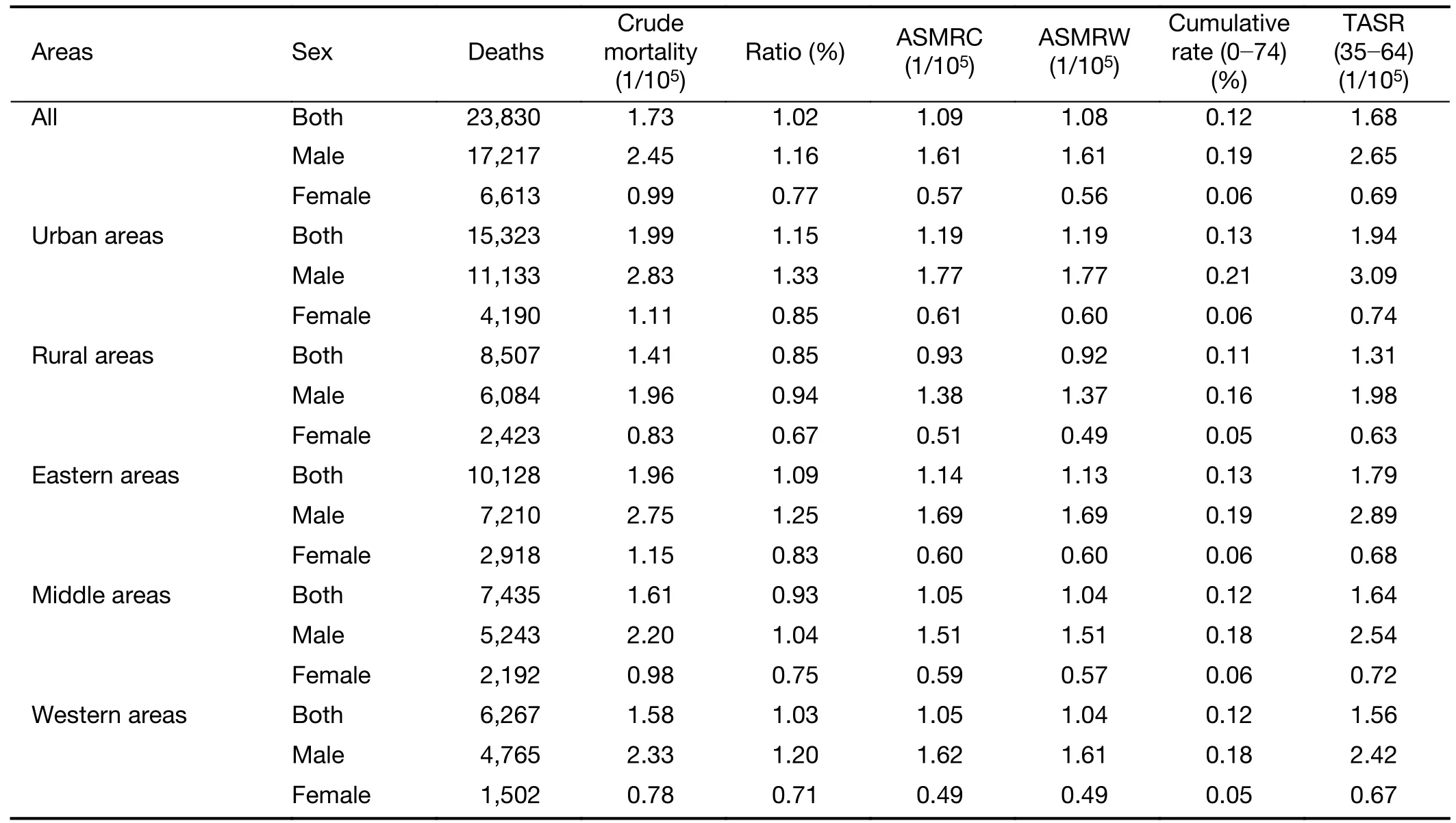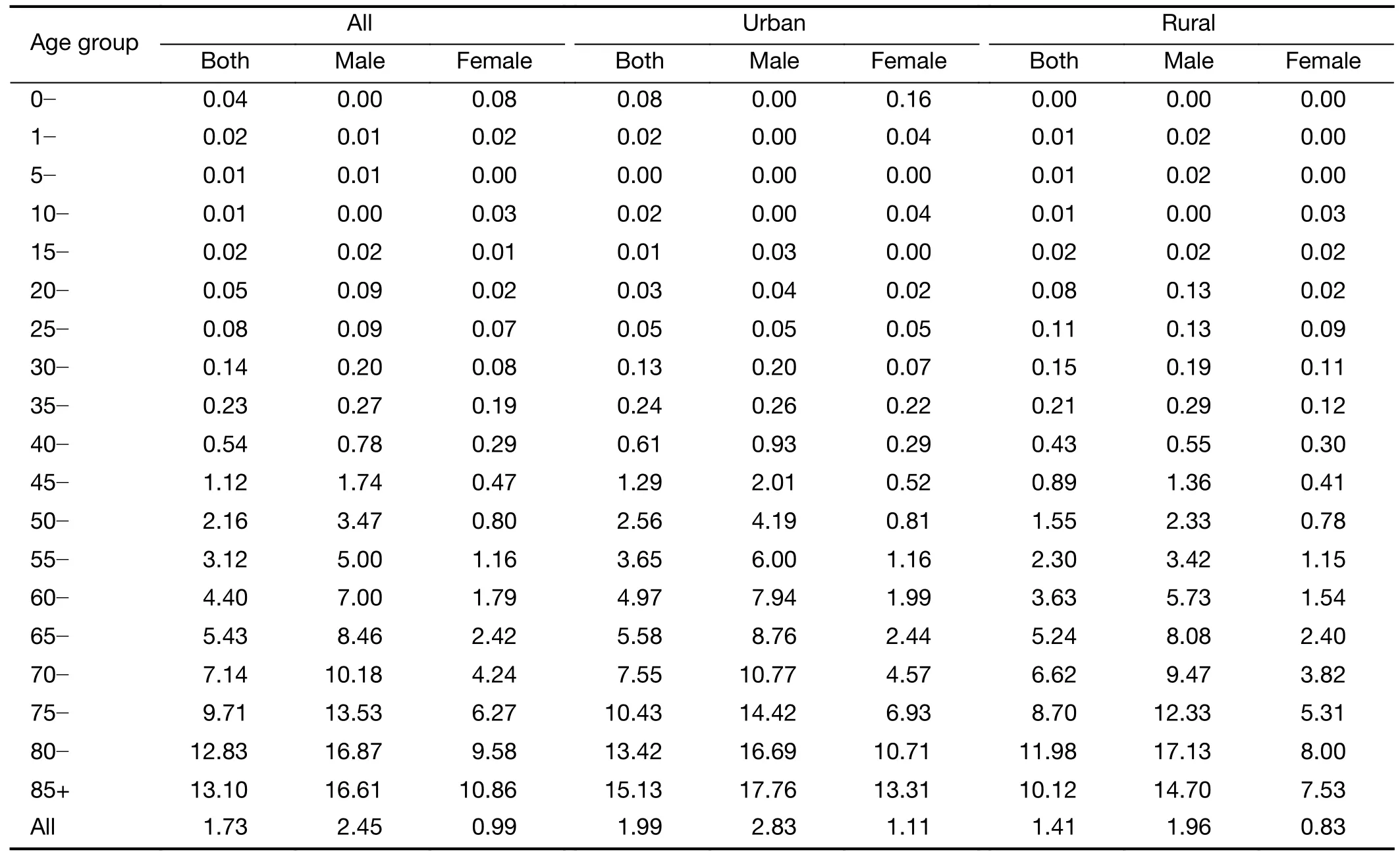Incidence and mortality of oral and oropharyngeal cancer in China,2015
2020-03-13LinLeiRongshouZhengKePengLeiSiJiPengWeicongCaiSiweiZhangWenqiangWeiJieHe
Lin Lei,Rongshou Zheng,Ke Peng,Lei Si,Ji Peng,Weicong Cai,Siwei Zhang,Wenqiang Wei,Jie He
1Department of Non-communicable Disease Control and Prevention,Shenzhen Center for Chronic Disease Control,Shenzhen 518020,China;2National Cancer Center/National Clinical Research Center for Cancer/Cancer Hospital,Chinese Academy of Medical Science and Peking Union Medical College,Beijing 100021,China;3The George Institute for Global Health,University of New South Wales,Sydney,NSW 2042,Australia
Abstract Objective:To report the incidence and mortality rates of oral and oropharyngeal cancer in Chinese population.Methods:Data were taken from a population-based cancer registry collected by the National Central Cancer Registry of China (NCCRC) in 2015.The data collected from 501 local cancer registries in China were assessed using NCCRC screening methods and criteria.Incidence and mortality rates of oral and oropharyngeal cancer were stratified by age group,gender,and area.Age-standardized incidence and mortality rates were adjusted using the Chinese standard population in 2000 and Segi’s world population.Results:In 2015,it was estimated that there were 51,765 oral and oropharyngeal cancer incident cases and 23,830 deaths in China.The crude incidence rate of oral and oropharyngeal cancer was 3.77/100,000,and the agestandardized incidence rate by Chinese standard population and by Segi’s world standard population were 2.55/100,000 and 2.49/100,000,respectively.The crude mortality rate and the age-standardized mortality rates by Chinese standard population and by Segi’s world standard population were 1.73/100,000,1.09/100,000 and 1.08/100,000,respectively.Both incidence and mortality rates of oral and oropharyngeal cancer were higher in males and in urban areas.Residents in eastern areas had the highest incidence and mortality rates,followed by those from middle areas and western areas.The rates of oral and oropharyngeal cancer increased greatly with age,especially after the age of 40 years.Conclusions:This study reports the latest incidence and mortality rates of oral and oropharyngeal cancer in China.Prevention intervention including early detection,treatment,and regular follow-ups is encouraged to be set up to reduce incidence and mortality rates of oral and oropharyngeal cancer in the future.
Keywords:Incidence;mortality;cancer registry;oral and oropharyngeal cancer;China
Introduction
Oral and oropharyngeal cancer is a current and growing problem in numerous countries but is under-investigated.According to the GLOBOCAN 2018,the annual incidence and mortality are estimated to be around 500,550 new cases and 250,565 deaths for oral and oropharyngeal cancer(excluding nasopharynx) in the world,accounting for 2.8%of all cancers and 2.6% of deaths caused by cancer (1).Population-based cancer registration data are usually considered as a reliable source to estimate the burden of cancer.Population-based cancer registries in China are managed by the National Central Cancer Registry of China(NCCRC) and data are collected by local reporting authorities.It is one of the largest networks of cancer registries in the world and has rapidly become one of the most commonly used data sources to investigate the epidemiology of cancer in China (2-4).To date,few studies have focused on the problem of oral and oropharyngeal cancer.We,therefore,carried out this study to report the incidence and mortality rates of oral and oropharyngeal cancer in Chinese population so as to provide a basis for the prevention and control of oral and oropharyngeal cancer.
Materials and methods
Data source
Cancer cases data were obtained from the NCCRC which is the center that managed the population-based cancer registration network in China.In 2019,NCCRC received the population-based cancer registration data of 2015 from 501 registries in 31 provinces,autonomous districts,and municipalities directly under the central government,including 160 cities (i.e.urban areas) and 289 counties and county-level cities (i.e.rural areas) which were the latest registration data.All submitted data were evaluated by going through quality control procedures to ascertain whether they met the quality criteria as stipulated in the Chinese Guideline for Cancer Registration (5) and Cancer Incidence in Five Continents Volume XI (6).Finally,cancer registration data from 368 registries including 134 urban areas and 234 rural areas met the quality criteria and were included for analysis.The 368 registries covered a population of 309,553,499 (148,804,626 in urban areas and 160,748,873 in rural areas;156,934,140 males and 152,619,359 females),accounting for 22.52% of the whole national population.
Classification of anatomical sites
Incident oral and oropharyngeal cancer was identified by codes C00−C14 [excluding nasopharynx (C11)]in the tenth edition of International Statistical Classification of Diseases(ICD-10),with the following anatomic sites:lip,tongue,and mouth (oral cavity) (C00−06),salivary glands(C07−08),oropharynx (C09−C10),and pharynx(C12−C13).
Quality control
The reliability,completeness,validity,and timeliness of the data are evaluated using several major indexes such as the percentage of cases morphological verified (MV%),percentage of death certificate-only cases (DCO%),mortality to incidence (M/I) ratio,and percentage of the diagnosis of unknown basis (UB%) (7).Eligible data to be further analyzed should meet the following criteria:MV%is not lower than 66% for all cancers combined,DCO% is lower than 15%,M/I is between 0.6 and 0.8,and UB% was lower than 5%.The corresponding values for MV%,DCO%,M/I and UB% were 41.63%,4.28%,0.72 and 1.03%,respectively.The quality indicators by sex at all registration areas each and combined were shown inTable 1.IARCcrg Tools (Version 2.05) issued by the International Agency for Research on Cancer/International Association of Cancer Registries (IARC/IACR) were used for data verification and evaluation.
Statistical analysis
The crude incidence and mortality rates were calculated by age group,gender,and area.The number of new cases and deaths was estimated using the age-specific cancer incidence and mortality rates and the corresponding populations.Age-standardized rates were estimated by using the Chinese population in 2000 and Segi’s world population.The population was estimated based on the data of Fifth and Sixth National Population Census conducted in 2000 and 2010 provided by the National Statistics Bureau of China,taking the changes of gender ratio,age composition,and the proportion of urban and rural transformation into account.The population in 2015 was stratified by age group (0,1−4,the 5-year interval from 5 to 84 years,and ≥85 years),gender (male/female),and area (urban/rural).According to the zoning,the population was stratified by geographical region.The eastern regions include Beijing,Tianjin,Hebei,Liaoning,Shanghai,Jiangsu,Zhejiang,Fujian,Shandong,Guangdong,and Hainan;the middle regions include Shanxi,Jilin,Heilongjiang,Anhui,Jiangxi,Henan,Hubei,and Hunan,and the western regions include Chongqing,Sichuan,Guizhou,Yunnan,Tibet,Shaanxi,Gansu,Qinghai,Ningxia,Xinjiang,Guangxi,and Inner Mongolia (8).The cumulative risk of developing or dying from primary oral and oropharyngeal cancer before 75 years of age (in the absence of competing causes of death) was calculated and presented as a percentage.All statistical analyses wereconducted using MS-Excel and SAS (Version 9.2;SAS Institute Inc.,Cary,USA).

Table 1 Quality control indexes of oral and oropharyngeal cancer in China in 2015
Results
Incidence rate of oral and oropharyngeal cancer
A total of 51,765 oral and oropharyngeal cancer cases were diagnosed in China in 2015,accounting for 1.32% of all incident cancer cases.The crude incidence rate of oral and oropharyngeal cancer was 3.77/100,000,and the agestandardized incidence rate by Chinese standard population(ASIRC) and Segi’s world standard population (ASIRW)was 2.55/100,000 and 2.49/100,000,respectively.
The incidence rate of oral and oropharyngeal cancer was higher in urban areas than in rural areas.The crude incidence rate,ASIRC and ASIRW were 4.40/100,000,2.87/100,000 and 2.79/100,000,respectively in urban areas,and 2.96/100,000,2.09/100,000 and 2.06/100,000,respectively in rural areas.Eastern areas population had the highest rates (the crude incidence rate,ASIRC and ASIRW were 4.44/100,000,2.90/100,000 and 2.79/100,000,respectively),followed by the people from middle and western areas.In addition,males had a higher crude incidence rate than females (4.92/100,000vs.2.55/100,000)irrespective of geographic locations (Table 2).
Distribution of incidence rate of oral and oropharyngeal cancer by age and geographic locations
The cumulative incidence rate was 0.29% for Chinese adults aged below 75 years.The number of oral and oropharyngeal cancer cases increased with age but decreased after the age of 65 years.The age-specific oral and oropharyngeal cancer incidence rate dramatically increased after 40 years and peaked in the age group of 80−84 years for both sexes.The age-specific incidence rate was higher in males than in females over the age of 40 years(Table 3,Figure 1).
The incidence rate was higher in urban areas than in rural areas,especially among the people aged 15 years and older in both sexes (Table 3).In addition,Eastern areas had the highest incidence rates in most age groups,except age groups of 10 years below,65−69,and 80−84 years old(Figure 2).
Mortality rate of oral and oropharyngeal cancer
A total of 23,830 deaths due to oral and oropharyngealcancer were reported,accounting for 1.02% of all cancer deaths.The crude mortality rate was 1.73/100,000.The age-standardized mortality rates by Chinese standard population (ASMRC) and Segi’s world standard population(ASMRW) were 1.09/100,000 and 1.08/100,000,respectively.

Table 2 Estimated new cases and incidence rates of oral and oropharyngeal cancer in China,2015
The mortality rate of oral and oropharyngeal cancer patients was higher in urban areas than in rural areas.The crude mortality rate,ASMRC and ASMRW were 1.99/100,000,1.19/100,000 and 1.19/100,000,respectively in urban areas,while 1.41/100,000,0.93/100,000 and 0.92/100,000,respectively in rural areas.The crude mortality,ASMRC and ASMRW in the eastern areas were the highest (1.96/100,000,1.14/100,000 and 1.13/100,000,respectively),followed by the middle and the western areas.Moreover,the mortality rate was 2.47 times higher in males than in females (2.45/100,000vs.0.99/100,000)(Table 4).
Distribution of mortality rate of oral and oropharyngeal cancer by age and geographic locations
The mortality rate of oral and oropharyngeal cancer was found to be the highest in males aged 60−64 years,while in females aged 80−84 years.The mortality rate of oral and oropharyngeal cancer was relatively low in age groups before 44 years old and then dramatically increased after 45 years old.Among patients aged 0−74 years,the cumulative mortality rate was 0.12%.The truncated mortality rate among patients aged 35−64 years old is 1.68/100,000.The highest mortality rate was observed in males aged 80−84 years and in females aged ≥85 years.The age-specific mortality was higher in males than in females since the age of 10 years (Table 4,Figure 3).
The mortality rate was higher in urban areas than in rural areas,particularly among people after the age of 35 years.The same trend was observed in both males and females aged 45−79 years (Table 5).Besides,the eastern areas had the highest mortality rates in the age groups of 10−34 and 50−64 years old.While,the western areas had the highest mortality rates in the age groups of 40−49,65−74,and ≥85 years old,and the middle areas had the highest mortality rates in the age groups of 35−39 and 80−84 years old (Figure 4).

Table 3 Age-specific incidence rates of oral and oropharyngeal cancer by areas in China,2015 (1/105)
Discussion
This study reported crude and standardized incidence and mortality rates of oral and oropharyngeal cancer in the Chinese population using a population-wide cancer registry.A total of 51,765 new oral and oropharyngeal cancer cases were diagnosed in China in 2015,accounting for 1.32% of all new cancer cases.The crude incidence rate,ASIRC and ASIRW were 3.77/100,000,2.55/100,000and 2.49/100,000,respectively.The crude mortality rate,ASMRC and ASMRW were 1.73/100,000,1.09/100,000 and 1.08/100,000,respectively.The incidence and mortality rates of oral and oropharyngeal cancer were found to be higher in urban areas than in rural areas,and higher in males than females.Further,the incidence rate of oral and oropharyngeal cancer peaked in the age group 80−84 years for both sexes.
Cancer registration is the most effective way to assess theburden of cancer.The incidence and mortality data in this study provided the most up-to-date information of oral and oropharyngeal cancer in China.China has a population of approximately 1.4 billion,the number of newly diagnosed oral and oropharyngeal cancer reported in our study was approximately 10.34% (51,765/500,550) of newly diagnosed cases and 9.51% (23,830/250,565) of deaths globally (1).The incidence and mortality rates of oral and oropharyngeal cancer in the study were lower than thosereported in high-risk countries such as South-Central Asia and South-Eastern Asia (9).However,a recent study revealed that the incidence and mortality rates increased stably in the past decade in China (10).Thus,there is an urgent call for comprehensive interventions to prevent oral and oropharyngeal cancer.

Table 4 Estimated deaths and mortality rates of oral and oropharyngeal cancer in China,2015
Tobacco smoking,including smokeless tobacco products and e-cigarette,is a confirmed major risk factor for oral and oropharyngeal cancer (11),and it is a big public health concern in China and there is no national smoking controlregulation.There were 27.7% of Chinese adults aged 15 years and over (52.1% in males and 2.7% in females)reported as current smokers (12).This may be a possible explanation for higher incidence and mortality rates in males compared to females in our study.

Table 5 Age-specific mortality rates of oral and oropharyngeal cancer by areas in China,2015 (1/105)
Besides tobacco smoking,chewing betel quid,with or without added tobacco,is another risk factor for cancer of the oral cavity (13-15).The prevalence of betel quid chewing is relatively higher in eastern and central China including Guangxi,Hainan,and Hunan provinces (16,17).This might contribute to the trend that higher incidence rates of oral and oropharyngeal cancer were reported in these areas in comparison with other provinces.
Several studies investigated the relation between human papillomavirus (HPV) infection and oral and oropharyngeal cancers (18,19).Fortunately,the HPV vaccine has been formulated and is widely used worldwide,which may virtually eliminate the diseases caused by HPV in the near future.
Consistent with previous research (10),the incidence rate of oral and oropharyngeal cancer was lower in rural areas.This may be attributed to that people lived in rural areas were more like to have less stress,a better environment,and more fruits and vegetable intake (20,21).Moreover,the level of economic development,less developed cancer reporting system,and cultural and dietary habits may also play a role in regional differences in disease distribution (22).Additionally,the highest incidence rate was found in the eastern areas,while the middle and western areas had higher mortality rates in most age groups — particularly in those aged ≥65 years.Enough attention should be paid to these high-risk populations when we develop and implement effective measures to reduce oral and oropharyngeal cancer.
Cancer screening is an effective way to reduce the burden of cancer diseases,especially colorectal and cervical cancer screening (23,24).However,there is no direct evidence that oral and oropharyngeal cancer screening can reduce morbidity or mortality in high-risk populations (25).Thus right screening project is clearly warranted to find in future research.
The Chinese government issued the Healthy China initiative to promote people’s health in 2019,in which cancer prevention was an important section.An oral health promotion strategy should be integrated with basic education on oral cancer for the Chinese population,implementation of campaigns on oral cancer awareness,appropriate screening programmers for oral cancer,and engagement in political measures to reduce tobacco and betel quid consumption.
Conclusions
This study provides the most up-to-date incidence and mortality rates of oral and oropharyngeal in China using a population-based cancer registry.Although the incidence and mortality rates of oral and oropharyngeal cancer were found relatively low,the disease and economic burden should not be neglected given a large population in China.Prevention intervention including early detection,treatment and regular follow-ups is encouraged to be set up to reduce incidence and mortality rates of oral and oropharyngeal cancer in the future.
Acknowledgements
This study was supported by the Sanming Project of Medicine in Shenzhen (No.SZSM201911015),the Natural Science Foundation of Guangdong Province (No.2020A151501478) and Major State Basic Innovation Program of the Chinese Academy of Medical Sciences (No.2018-I2M-3-003).Dr Lei Si is supported by a National Health and Medical Research Council Early Career Fellowship (No.GNT1139826).
Footnote
Conflicts of Interest:The authors have no conflicts of interest to declare.
杂志排行
Chinese Journal of Cancer Research的其它文章
- Incidence and mortality of laryngeal cancer in China,2015
- Updates on larynx cancer epidemiology
- An exploration for quantification of overdiagnosis and its effect for breast cancer screening
- Effects of neoadjuvant chemotherapy on respiratory function in patients with breast cancer
- Factors associated with metastasis in superior mesenteric vein lymph node in subtotal gastrectomy for gastric cancer:Retrospective case control study
- Prognostic impact of D2-plus lymphadenectomy and optimal extent of lymphadenectomy in advanced gastric antral carcinoma:Propensity score matching analysis
